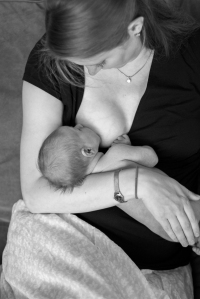by Kate Saumweber Hogan, CPM, LM
What do you need to successfully nurse your baby? Well, if you are already pregnant, then quite simply, you already have what you need: you baby and your breasts!
Some babies love to nurse upon arrival, and already know how to be a masterful nurser…and others need a lot of support and guidance. Remember, there are two people in the breastfeeding relationship, so even if mom is doing everything “right,” baby still has to do his part of the job too.
Keeping a relaxed attitude and a sense of humor can go a long way in a nursing relationship. Since babies can feel your stress and anxiety, laughter can help to keep all of those good hormones and bodily fluids flowing!
What about all of that other breastfeeding stuff on your suggested baby registry list? Here is my list of things to consider having on hand:
- A good nipple cream: If this is your first time nursing, there will likely be at least a tad bit of nipple soreness. If you get nothing else, it would be useful to have a good nipple cream already on hand; many moms start using it in the first 24-48 hours. In my practice, moms most often prefer Motherlove’s nipple cream and Earth Mama Angel Baby Natural Nipple Butter. These two seem to not only protect, but also heal nipples faster than some of the other common nipple creams out there. You can find these online, at Whole Foods, and also at some of our local birth related business around town.
- Gel pads: At the first sight or sense of any nipple cracking, bleeding, or blisters, you’ll want to start using gel pads. Even if your breasts are just feeling tender between nursing sessions, you can start using these to help protect your nipple from rubbing against fabric of your bra or shirt. These incredible little inventions are like a gel sticker that helps protect and heal the nipple. You can use them in conjunction with nipple cream (after nursing apply some nipple cream, and then apply the gel pad). The two brands I recommend are Madela’s Tender Care Hydrogel Nursing Pads and Lansinoh‘s Soothies Gel Pads. Sometimes partners will put them in the fridge during a nursing session, and then you can apply the cool pads after baby is done eating. They are meant to be reused for 24-72 hours. I think it is nice to have at least one box of these on hand, especially for first time moms.
- Nursing tank top: You won’t be able to pick out a nursing bra until your milk has come in and your supply has eve
ned out (a great outing for 2-3 weeks postpartum), but it might be nice to have some stretchy nursing support options for the first couple weeks. Nursing tank tops are tanks with some light support built in, while also allowing you to unclip from the strap to give your baby access to your nipple. Night nursing bras are like stretchy sports bras, and you would likely be able to pick out one that fits at the end of your pregnancy, that will stretch enough to support you through the first couple weeks.
- Breast Pump: If you are planning to get a pump at some point, it can be nice to have it prior to labor. It is rare, but every once in a while it is nice to use a breast pump in labor to help stimulate contractions (nipple stimulation releases oxytocin, the natural form of pitocin, which brings on labor surges). Be sure to check to see if your insurance covers your breast pump; most plans do! I’ve been hearing lots of recommendations for the Hygeia breast pump lately since it is a closed system which is rated for multiple users. Since the milk can’t get into the motor, it is okay to share this brand of pump (of course with new tubing and parts each time), and you don’t have to worry about mold or dust getting into the motor. Most pumps aren’t meant to share, so be sure to do your research if you are considering borrowing a friend’s or buying one used on craigslist.
- Hands Free Pumping Bra: If you are going to need to pump regularly (such as going back to work), then you will absolutely want a hands free pumping bra. This super smart apparatus holds your pump flanges securely to your breasts while pumping, freeing up your hands to do other things. Think of things like checking email, doing paperwork, reading a book, updating Facebook, even driving (just make sure you set it up before you pull out of the garage…and not recommended with a convertible or motorcycle), all while expressing milk! It will allow you to truly multitask, and maybe even justify a bit of extra mommy zone-out time!
- Lactation Consultant contact info: Breastfeeding shouldn’t be painful! Other than a little latch pain which fades away after 10-15 seconds, and a bit of tenderness in the first few days as your nipples adjust to nursing, breastfeeding shouldn’t hurt! If it does, then something needs to be adjusted. Most often it is the latch, sometimes it’s positioning, or it could even be a baby’s short frenulum. Whatever the issue may be, you do not need to problem solve alone. We are in an amazing community that is full of support. Be sure to check out the Childbirth Collective’s member directory to get in touch with a lactation support specialist. You can even request a few hours of lactation help or postpartum doula support as a baby shower gift!
- Privacy and Rest: Unlike many other cultures around the world, we don’t have a huge tradition of postpartum rest and pampering (unfortunately!). It is so important for you and your new family to get lots of skin to skin time together, and sometimes that can be hard to do in front of visitors. When baby arrives, allow yourself at least two weeks of lounging in bed, with minimal visitors, so that you and baby can figure out what works best for you, in your own time and pace. Have your lactation consultant and other support people come to you, so that you aren’t wearing yourself out by having to get dressed, get a diaper bag packed, and get yourself out of the house so early on.
Surround yourself with love and support, keep a lighthearted attitude, and please please please ask for help at any early signs of breastfeeding troubles. Happy nursing!
Kate Saumweber Hogan is a certified professional midwife and licensed midwife, serving Minnesota and Wisconsin. She is the owner of Twin Cities Midwifery where she provides prenatal, home birth, newborn, and postpartum care. She sees families at clinic spaces in Minneapolis and White Bear Lake, and lives in south Minneapolis with her husband and nursing daughter, born at home in the water in December 2012.



